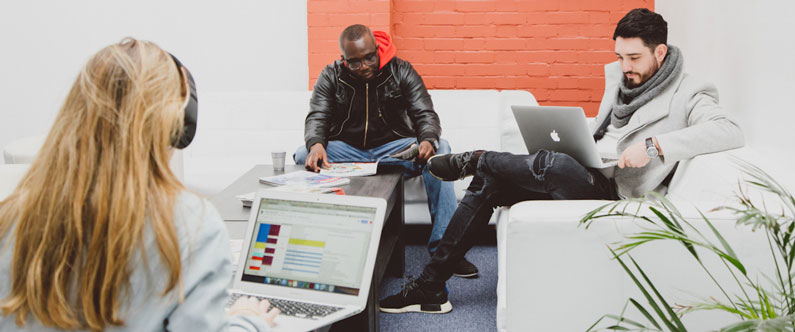Designed for a creative working life

What makes the ideal campus environment? For SAE Creative Media Institute, it should reflect the professional creative ethos of our students’ future workplace to provide a truly ‘real world’ learning environment. It needs to enable active, collaborative project-based education, and provide the latest high-end industry equipment.
Like many other institutions, we also want to create a ‘sticky’ campus: one our students will want to stay at longer than the timetable dictates. But we don’t see that as being solely a start-up HQ vibe with a hip café – or a colourful day-care centre for adult learners.
For more than 40 years, SAE has developed its learning and teaching practices by building on social constructivist principles – where people, technology and environment connect. So we recently applied our experiential learning approach to a revamp of many campuses across Australia and Europe.
Campuses still matter in a digital world
These days, students can study anywhere they have Wi-Fi and a power point. But we want to coax students out of conventionally insular 21st century study spaces (cafes, malls and their bedrooms) and into spaces designed for productive learning – namely, the studio.
Learning takes place continuously with mixed practical tasks, through interaction with peers and staff, self-directed study, instruction, demonstrations, experimentation and observation. Once formal classes conclude, students still need time to work individually and together – using the studio technology, post-production rooms, green screens and portable gear.
That’s why we didn’t just limit the revamp to studios and labs. Well-designed formal and informal spaces create a thriving social hub that is proven to relieve stress, and increases interaction between student and staff – fostering greater collaboration and discovery across different specialties.
Industry engagement is key to the design and delivery of the programs at SAE, so we closely integrate with local creatives. By replicating the visually appealing habitats of creative working professionals. This approach also strengthens our relationships.
Creative agencies know their aesthetic spaces do more than impress visiting clients. They also improve wellbeing and creativity. So by re-modelling SAE campus, we also pass these positive outcomes directly to students and staff.
One-fifth of our campuses are already improving student experience through these redesigned learning spaces. SAE Paris now focuses less on traditional lectures, instead offering high-tech innovation spaces and small-scale creative hubs where students have the opportunity to collaborate and nurture the soft skills industry leaders increasingly want.
Watch this video to tour the new SAE Institute Paris space.
SAE Institute Vienna was established 31 years ago, and its recent relocation to the city centre was an opportunity to design a contemporary creative media industry space.

Photo: SAE Vienna recreates the professional environment
Designing a better learning experience
Through this process, we learned some key principles behind effective learning environments.
First, we need to support autonomy in an authentic workspace, so students can engage in self-directed learning. By taking responsibility for their own learning, students make their own decisions about what they want to focus on.
Boud’s research indicates self-directed learning also encourages students to:
- Plan their learning experiences
- Find resources required for learning
- Create problems to challenge themselves
- Be autonomous in where and when they learn
- Continue learning outside the educational institution.
Secondly, welcoming and home-like comfort provide a space where students will want to learn, live and thrive. This includes simple way-finding, openness and security.
We also wanted to focus less on traditional lectures and isolated study, and more on project-based learning and cross-campus collaboration. Lecturers are already developing more sophisticated and interactive lessons – using virtual reality technology, or interacting with students through mobile technology in the classroom.
Finally, our design aesthetic reflects the local creative culture and individuality. Some campuses commissioned street artists to fill blank walls to reflect an authentic youth culture.
All these factors combine in a more contemporary creative space; an authentic environment with essential technical gear led by practitioner-educators, fostering an engaging and effective learning environment.
PEN research (psychology, education and neuroscience) shows that strong first impressions have a positive impact on learning – influencing how students behave and how they approach future lessons. A sticky campus engages students, and engaged students become successful graduates.